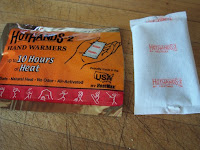(Click for larger image)
Lesson: Exothermic reactions produce heat
What Happened: Iron powder began oxidizing (rusting) when exposed to the air, becoming hot
As soon as I poured the powder into the mason jar, it started to heat up. I don't know how hot it got (Note to self: Get thermometer!) but I suspect it was hotter than the temperatures listed above, because it didn't last as long. Probably because it was exposed to more air than if I had left it in the air-permeable packet. It may have dried out quicker, too.Lesson: Exothermic reactions produce heat
What Happened: Iron powder began oxidizing (rusting) when exposed to the air, becoming hot
Although you can't see it in the picture at the top, there was smoke coming out of the jar. We also tried mixing some with a little more water to see what happened. The heating process stopped. However, when I dipped a magnet into the resulting goop it did act a little like ferrofluid.
What's going on (from Camping Survival):
The heating process takes place in this fashion:And the chemical equation (from Curriki, which tells you how to mix up your own):
- The iron in the pouch, when exposed to oxygen, oxidizes and therefore produces heat (aka, "Air Activated").
- When iron oxidizes it produces iron oxide, more commonly referred to as rust.
- The salt acts as a catalyst.

- The carbon [activated charcoal] helps disperse the heat.
- The vermiculite [the shiny mica-like specks] acts as an insulator for the purpose of retaining the heat and the cellulose is added as a filler.
- All of these ingredients are surrounded by a polypropylene bag.
- Polypropylene allows air to permeate the ingredients while holding in moisture.
Hand warmers work because of a rusting process. The rusting is a redox reaction and the equation is as follows: 4Fe(s) + 3O2(g) -> 2Fe2O3(s) .
































